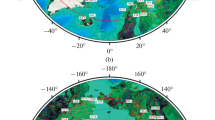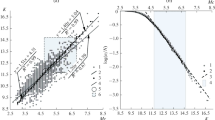Abstract
An important part of the preparation and homogenization of the seismic catalog used in the recent seismic hazard assessment study of Spain is the development of relationships among the different scales used to measure earthquake size. The objective is to convert all earthquake size data in the original catalog to a single magnitude scale, the moment magnitude M w, in order to have a set of events with an uniform comparable size measurement. These new relationships are based on regression analysis between M w and the other units used in the catalog in different epochs. The reduced major axis regression scheme is used, because it is the most suitable method for symmetric treatment of the variables involved in the fits. The new relationships obtained for Spain, M w as a function of m bLg; M w as a function of m b; and M w as a function of I max, are presented and their applicability limits and accuracy are discussed. The results obtained could have other practical uses in regional seismicity analysis.











Similar content being viewed by others
References
Babu, G. J. and E. D. Fiegelson. (1992). Analytical and Monte Carlo comparisons of six different linear least squares fits. Communications in Statistics—Simulation and Computation 21(2): 533–549.
Bormann P. and D. Di Giacomo (2011). The moment magnitude Mw and the energy magnitude Me: common roots and differences. J. Seismol. 15, 411–427. doi:10.1007/s10950-010-9219-2.
Bormann, P., Wendt, S., Di Giacomo, D. (2013). Seismic Sources and Source parameters. - In: Bormann, P. (Ed.), New Manual of Seismological Observatory Practice 2 (NMSOP2), Potsdam: Deutsches GeoForschungsZentrum GFZ, p. 1–259. doi:10.2312/GFZ.NMSOP-2_ch3.
Braunmiller J., Deichmann N., Giardini D., Wiemer S. and the SED Magnitude Working Group (2005). Homogeneous Moment-Magnitude Calibration in Switzerland. Bull. Seism. Soc. Am., 95, 58–74.
Carranza, M., E. Buforn, S. Colombelli, and A. Zollo (2013). Earthquake early warning for southern Iberia: A P wave threshold-based approach. Geophysical research letters Vol 40, 1–6, doi:10.1002/grl.50903, 2013.
Castellaro, S. and Bormann, P. (2007). Performance of Different Regression Procedures on the Magnitude Conversion Problem. Bull. Seism. Soc. Am., 97, 1167–1175.
Castellaro, S., Mulargia, F., Kagan, Y. Y. (2006). Regression problems for magnitudes. Geophys. J. Int., 165, 913–930.
Chen, K-P. and Y-B Tsai (2008). A Catalog of Taiwan Earthquakes (1900–2006) with Homogenized Mw Magnitudes, Bull. Seism. Soc. Am., vol. 98, 483–489, doi:10.1785/0120070136.
Draper N. R. and H. Smith (1998). Applied Regression Analysis. 3rd edition. J. Wiley & Sons Inc. Wiley Series in Probability and Statistics. 1998. ISBN: 0-471-17082-8.
Dreger D. S. and Helmberger D. V. (1993). Determination of source parameters at regional distances with three-component sparse network data. J. Geophys. Res. 98, 8107–8125.
Fukao, Y. (1973). Thrust Faulting at Lithospheric Plate Boundary. The Portugal Earthquake of 1969. Earth and Planetary Science Lett. 18, 205–216.
García-Blanco, R. M. (2009). Caracterización del potencial sísmico y su influencia en la determinación de la peligrosidad sísmica probabilística. Tesis doctoral. E. T. S. I. Minas. (UPM).
Gaspar-Escribano, J. M., Jiménez Peña, M. E., Pastor, J. J., Benito, B. (2008). Sobre la medida del tamaño del terremoto y la peligrosidad sísmica en España. 6ª Asamblea Hispano-Portuguesa de Geodesia y Geofísica.
Gorgas J., Cardiel N. and Zamorano J. (2009). Estadística básica para estudiantes de Ciencias. Fac. de C. C. Físicas. Universidad complutense de Madrid. 2009. ISBN: 978-84-691-8981-8.
Grünthal, G. and Wahlström, R. (2012). The European-Mediterranean Earthquake Catalogue (EMEC) for the last millennium, J. Seismol., 16, 535–570. doi:10.1007/s10950-012-9302-y.
IGN (2014). Descripción del Tipo de magnitud. Servicio de Información Sísmica IGN. www.ign.es/ign/head/sismoTipoMagnitud.do. (Last visited: 2014 June).
IGN-UPM Working Group (2013). Actualización de mapas de peligrosidad sísmica de España. 2012. Instituto Geografico Nacional, 267 pp. ISBN-978-84-416-2685-0.
ISC (2010). International Seismological Centre, On-line Bulletin, http://www.isc.ac.uk, Internatl. Seis. Cent., Thatcham, United Kingdom, 2010.
ISO/IEC (2008). ISO/IEC 98-3: Uncertainty of measurement -Part 3: Guide to the expression of uncertainty in measurement.
Isobe, T., E. D. Fiegelson, M. G. Akritas, and G. J. Babu. (1990). Linear regression in astronomy I. Astrophysical Journal 364: 104–113.
Johnston, A. C. (1996a). Seismic moment assessment of earthquakes in stable continental regions-I. Instrumental seismicity. Geophys. J. Int., 124, 381–414.
Johnston, A. C. (1996b). Seismic moment assessment of earthquakes in stable continental regions-II Historical seismicity. Geophys. J. Int. 125, 639–678.
Kanamori, H. (1977). The energy release in great earthquakes, J. Geophys.Res. 82, 2981–2987.
López, C. and Muñoz, D. (2003). Fórmulas de magnitud en los boletines y catálogos españoles, Física de la Tierra, 15, 49–71.
López, C. (2008). Nuevas Fórmulas de Magnitud para la Península Ibérica y su entorno. Trabajo de Investigación del Máster de Geofísica y Meteorología. Universidad Complutense de Madrid. Facultad de Ciencias Físicas. 38 pp.
López Arroyo, A. y Udías, A. (1972). Aftershock Sequence and Focal Parmeters of February 28, 1969 Earthquake of the Azores-Gibraltar Fracture Zone. Bull. Seism. Soc. Am., 63, 699–720.
Martínez Solares, J. M. and Mezcua, J. (2002). Catálogo Sísmico de la Península Ibérica (800 a. C.-1900). Monografía No. 18. Instituto Geográfico Nacional. 253 pp.
McArdle, B. H. (2003). Lines, models, and errors: regression in the field. Limnology and Oceanography 48(3): 1363–1366.
Mezcua J. (1982). Catálogo General de Isosistas de la Península Ibérica. Publicación 202. Instituto Geográfico Nacional. Madrid. 322 pp.
Mezcua J. (2002). Curso de ingeniería sísmica. Universidad Politécnica de Madrid, 327 pp.
Mezcua, J. Martínez Solares, J. M (1983). Sismicidad del área Ibero-Mogrebí. Publicación 203. Instituto Geográfico Nacional. Madrid. 301 pp.
Munuera J. M. (1963). A study of seismicity on the Peninsula Ibérica area. Technical note num 1: Seismic Data. Instituto Geográfico Nacional. Madrid. 93 pp.
Nuttli, O. (1973). Seismic Wave attenuation and magnitude relations for Eastern North America. J. Geophys. Res. 78, 876–885.
Papazachos B. C., Kiratzi A. A., Karacostas B. G. (1997). Towards a homogeneous moment-magnitude determination for earthquakes in Greece and the surrounding area. Bull Seismol Soc Am 87, 474–483.
Pondrelli, S., Ekstrom, G., Morelli, A. and Primerano, S. (1999). Study of the source geometry for tsunamigenic events of the Euromediterranean area. In international Conference on Tsunamis. pp 297–307. UNESCO books. Paris.
Rueda, J. (2006). Discriminación sísmica mediante el análisis de las señales generadas por explosiones y terremotos. Aplicación a la región suroeste de Europa-Norte de África. Tesis Doctoral ETSIA-UPM.
Rueda, J. and Mezcua, J. (2001). Sismicidad, sismotectónica y peligrosidad sísmica en Galicia. Instituto Geográfico Nacional. Publicación Técnica n. 35.
Rueda, J. and Mezcua, J. (2002). Estudio del terremoto de 23 de septiembre de 2001 en Pego (Alicante). Obtención de una relación mbLg-Mw para la Península Ibérica. Rev. Soc. Geol. España. 15 (3–4), 159–173.
Rueda, J. and Mezcua, J. (2005). Near-real-time Seismic Moment-tensor Determination in Spain. Seism. Res. Lett. 76, 455–465.
Satriano, C., Wu Y., Zollo A., and Kanamori H. (2011). Earthquake early warning: Concepts and physical grounds. Soil Dynamics and Earthquake Eng. 31, 2, 106–118.
Scordilis EM (2006). Empirical global relations converting MS and mb to moment magnitude. J Seismol 10: 225–236.
Sonley E. and Atkinson G. M. (2005). Magnitude and Nuttli Magnitude for Small-magnitude Earthquakes in Southeastern Canada. Seismol. Res. Lett. Vol. 76, Num. 6, 752–755.
Stich D., Ammon, C. J. and Morales, J. (2003). Moment tensor solutions for small and moderate earthquakes in the Ibero-Maghreb region. J. Geophys. Res., 108, 2148, doi:10.1029/2002JB002057, 2003.
Stich D., Martín, R., Morales, J. (2010). Moment tensor inversión for Iberia-Maghreb earthquakes 2005–2008. Tectonophysics, 483, 390–398.
Stucchi M., Rovida, A., Gomez Capera, A. A., Musson, R., Papaioannou, Ch., Batlló, J. (2010). European Earthquake Catalogue (1000–1963; M > 5.8). Proyecto Neries Deliverable D10-NA4. EC project number: 026130.
Tofallis, C (2000). Multiple Neutral Regression. Business School Working Papers, vol. UHBS 2000–13, Operational Research Paper, vol. 14, University of Hertfordshire.
Tofallis, C. (2003). Multiple neutral data fitting. Annals of Operations Research, Vol. 124, pp 69–79. Kluwer Academic Publishers.
Udías, A., López Arroyo A. (1970). Body and Surface Wave Study of Source parameters of the March 15, 1964 Spanish Earthquake. Tectonophysics, 9, 323–346.
Veith K. F. and Clawson, G. E. (1972). Magnitude from short period P-wave data. Bull. Seism. Soc. Am., 62, 435–452.
Vilanova, S. P. y Fonseca, J. B. F. D. (2007). Probabilistic Seismic-hazard Assesment for Portugal. Bull. Seism. Soc. Am., 97, pp. 1702–1717.
Wessel, P., and W. H. F. Smith (1998) New, improved version of Generic Mapping Tools released, EOS Trans. Amer. Geophys. U., vol. 79 (47), pp. 579, 1998.
Wu, Y.-M., and H. Kanamori (2005a), Experiment on an onsite early warning method for the Taiwan early warning system, Bull. Seism. Soc. Am., 95, 347–353.
Wu, Y.-M., and H. Kanamori (2005b), Rapid assessment of damage potential of earthquakes in Taiwan from the beginning of P-waves, Bull. Seism. Soc. Am., 95, 1181–1185. Wu, Y.-M., and L. Zhao (2006), Magnitude estimation using the first three seconds P-wave amplitude in earthquake early warning, Geophys. Res. Lett., 33, L16312, doi:10.1029/2006GL026871.
York D. (1969). Least squares fitting of a straight line with correlated errors. Earth and Planet. Sci. Lett., 5, 320–324.
York D., Evensen, N. M., López Martínez, M., and De Basabe Delgado, J. (2004). Unified equations for the slope, intercept, and standard errors of the best straight line. Am J. Phys., 72(3), 367–375.
Zollo, A., M. Lancieri, and S. Nielsen (2006). Earthquake magnitude estimation from peak amplitudes of very early seismic signals on strong motion records, Geophys. Res. Lett., 33, L23312, doi:10.1029/2006GL027795.
Author information
Authors and Affiliations
Corresponding author
Electronic supplementary material
Below is the link to the electronic supplementary material.
Rights and permissions
About this article
Cite this article
Cabañas, L., Rivas-Medina, A., Martínez-Solares, J.M. et al. Relationships Between M w and Other Earthquake Size Parameters in the Spanish IGN Seismic Catalog. Pure Appl. Geophys. 172, 2397–2410 (2015). https://doi.org/10.1007/s00024-014-1025-2
Received:
Revised:
Accepted:
Published:
Issue Date:
DOI: https://doi.org/10.1007/s00024-014-1025-2




